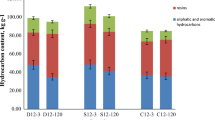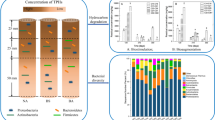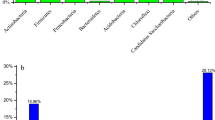Abstract
Chemical oxidation as a pretreatment step coupled with bioremediation for petroleum-contaminated soil may pose serious impacts on indigenous microorganisms and the available nutrients. Petroleum-contaminated soil were treated by hydrogen peroxide (H2O2) at initial concentrations of 105 mM (HH), 21 mM (HL), and 105 mM in three equal amounts (HT) without adding any external catalyst. The contents of total petroleum hydrocarbons (TPH) and dissolved nutrients (total organic compounds, nitrogen, and phosphate), and the indigenous bacteria community succession (analyzed by high-throughput sequencing of 16S rDNA) were investigated over 50 days. Compared to the control treatment without H2O2 addition, H2O2 treatments for the petroleum-contaminated soil significantly promoted the TPH removal especially in the first 4 days and impacted the contents of dissolved nutrients. Both of chemical oxidation and nutrients contributed to microbial community structure changes in alpha diversity. Although the soil microbial community structure had undergone significant changes after different chemical oxidation pretreatments, Firmicutes, Proteobacteria, Gemmatimonadetes, and Actinobacteria were the main bacterial phyla. Compared with adding H2O2 at one time, H2O2 added in stepwise was beneficial to indigenous bacterial diversity recovery and TPH removal. H2O2 oxidation treatments showed a great influence on the microbial community structures in the start-up stage, while recovery time rather than the oxidation treatments presented greater effects on the composition of the microbial community structure with the incubation time extended. Therefore, adding H2O2 as pretreatment for petroleum-contaminated soil showed little effect on the structure of soil indigenous microbial community from a long-term scale, and was conducive to the continuous removal of TPH by indigenous microorganisms.






Similar content being viewed by others
Data availability
The datasets used and/or analyzed during the current study are available from the corresponding author on reasonable request.
References
Bao Y-J, Xu Z, Li Y, Yao Z, Sun J, Song H (2017) High-throughput metagenomic analysis of petroleum-contaminated soil microbiome reveals the versatility in xenobiotic aromatics metabolism. J Environ Sci 56:25–35. https://doi.org/10.1016/j.jes.2016.08.022
Biache C, Lorgeoux C, Andriatsihoarana S, Colombano S, Faure P (2015) Effect of pre-heating on the chemical oxidation efficiency: implications for the PAH availability measurement in contaminated soils. J Hazard Mater 286:55–63. https://doi.org/10.1016/j.jhazmat.2014.12.041
Chen K-F, Chang Y-C, Chiou W-T (2016) Remediation of diesel-contaminated soil using in situ chemical oxidation (ISCO) and the effects of common oxidants on the indigenous microbial community: a comparison study. J Chem Technol Biotechnol 91:1877–1888. https://doi.org/10.1002/jctb.4781
French KE, Zhou Z, Terry N (2020) Horizontal ‘gene drives’ harness indigenous bacteria for bioremediation. Sci Rep 10:15091. https://doi.org/10.1038/s41598-020-72138-9
Gong X-B (2012) Remediation of weathered petroleum oil-contaminated soil using a combination of biostimulation and modified Fenton oxidation. Int Biodeterior Biodegrad 70:89–95. https://doi.org/10.1016/j.ibiod.2012.02.004
Highton R (1993) The relationship between the number of loci and the statistical support for the topology of UPGMA trees obtained from genetic distance data. Mol Phylogenet Evol 2:337–343. https://doi.org/10.1006/mpev.1993.1033
Jung H, Ahn Y, Choi H, Kim IS (2005) Effects of in-situ ozonation on indigenous microorganisms in diesel contaminated soil: survival and regrowth. Chemosphere 61:923–932. https://doi.org/10.1016/j.chemosphere.2005.03.038
Khan MAI et al (2018) Microbial diversity changes with rhizosphere and hydrocarbons in contrasting soils. Ecotoxicol Environ Saf 156:434–442. https://doi.org/10.1016/j.ecoenv.2018.03.006
Liang C, Huang C-F, Chen Y-J (2008) Potential for activated persulfate degradation of BTEX contamination. Water Res 42:4091–4100. https://doi.org/10.1016/j.watres.2008.06.022
Lim MW, Von Lau E, Poh PE (2016) A comprehensive guide of remediation technologies for oil contaminated soil—present works and future directions. Mar Pollut Bull 109:14–45. https://doi.org/10.1016/j.marpolbul.2016.04.023
Liu L et al (2018) Crude oil removal from aqueous solution using raw and carbonized Xanthoceras sorbifolia shells. Environ Sci Pollut Res 25:29325–29334. https://doi.org/10.1007/s11356-018-2895-0
Liu Q, Tang J, Liu X, Song B, Zhen M, Ashbolt NJ (2019) Vertical response of microbial community and degrading genes to petroleum hydrocarbon contamination in saline alkaline soil. J Environ Sci 81:80–92. https://doi.org/10.1016/j.jes.2019.02.001
Lu M, Zhang Z, Qiao W, Wei X, Guan Y, Ma Q, Guan Y (2010) Remediation of petroleum-contaminated soil after composting by sequential treatment with Fenton-like oxidation and biodegradation. Bioresour Technol 101:2106–2113. https://doi.org/10.1016/j.biortech.2009.11.002
Margesin R, Hammerle M, Tscherko D (2007) Microbial activity and community composition during bioremediation of diesel-oil-contaminated soil: effects of hydrocarbon concentration, fertilizers, and incubation time. Microb Ecol 53:259–269. https://doi.org/10.1007/s00248-006-9136-7
Martinez-Pascual E, Grotenhuis T, Solanas AM, Vinas M (2015) Coupling chemical oxidation and biostimulation: effects on the natural attenuation capacity and resilience of the native microbial community in alkylbenzene-polluted soil. J Hazard Mater 300:135–143. https://doi.org/10.1016/j.jhazmat.2015.06.061
Medina R, David Gara PM, Jose Fernandez-Gonzalez A, Alejandra Rosso J, Teresa Del Panno M (2018) Remediation of a soil chronically contaminated with hydrocarbons through persulfate oxidation and bioremediation. Sci Total Environ 618:518–530. https://doi.org/10.1016/j.scitotenv.2017.10.326
Palmroth MRT, Langwaldt JH, Aunola TA, Goi A, Puhakka JA, Tuhkanen TA (2006) Treatment of PAH-contaminated soil by combination of Fenton’s reaction and biodegradation. J Chem Technol Biotechnol 81:598–607. https://doi.org/10.1002/jctb.1476
Pardo F, Rosas JM, Santos A, Romero A (2014) Remediation of a biodiesel blend-contaminated soil by using a modified Fenton process. Environ Sci Pollut Res 21:12198–12207. https://doi.org/10.1007/s11356-014-2997-2
Sahl J, Munakata-Marr J (2006) The effects of in situ chemical oxidation on microbiological processes: a review. Remediat J 16:57–70. https://doi.org/10.1002/rem.20091
Santos HF, Cury JC, Carmo FL, Rosado AS, Peixoto RS (2010) 18S rDNA Sequences from microeukaryotes reveal oil indicators in mangrove sediment. PLoS ONE. https://doi.org/10.1371/journal.pone.0012437
Shahi A, Aydin S, Ince B, Ince O (2016) Reconstruction of bacterial community structure and variation for enhanced petroleum hydrocarbons degradation through biostimulation of oil contaminated soil. Chem Eng J 306:60–66. https://doi.org/10.1016/j.cej.2016.07.016
Sutton NB, Grotenhuis T, Rijnaarts HHM (2014a) Impact of organic carbon and nutrients mobilized during chemical oxidation on subsequent bioremediation of a diesel-contaminated soil. Chemosphere 97:64–70. https://doi.org/10.1016/j.chemosphere.2013.11.005
Sutton NB et al (2014b) Recovery of microbial diversity and activity during bioremediation following chemical oxidation of diesel contaminated soils. Appl Microbiol Biotechnol 98:2751–2764. https://doi.org/10.1007/s00253-013-5256-4
Vinas M, Sabate J, Guasp C, Lalucat J, Solanas AM (2005) Culture-dependent and -independent approaches establish the complexity of a PAH-degrading microbial consortium. Can J Microbiol 51:897–909. https://doi.org/10.1139/w05-090
Watts RJ, Dilly SE (1996) Evaluation of iron catalysts for the Fenton-like remediation of diesel-contaminated soils. J Hazard Mater 51:209–224. https://doi.org/10.1016/S0304-3894(96)01827-4
Yang B, Chen K, Li Q, Liu Y (2019) Persistence and effectiveness of oxidants during the treatment of petroleum-contaminated soil by chemical oxidation with Na2S2O8 and H2O2. J Agro-Environ Sci 38:2377–2385 (in Chinese)
Xu J, Deng X, Cui Y, Kong F (2016) Impact of chemical oxidation on indigenous bacteria and mobilization of nutrients and subsequent bioremediation of crude oil-contaminated soil. J Hazard Mater 320:160–168. https://doi.org/10.1016/j.jhazmat.2016.08.028
Xu J, Xin L, Huang T, Chang K (2011) Enhanced bioremediation of oil contaminated soil by graded modified Fenton oxidation. J Environ Sci 23:1873–1879. https://doi.org/10.1016/S1001-0742(10)60654-7
Yen C-H, Chen K-F, Kao C-M, Liang S-H, Chen T-Y (2011) Application of persulfate to remediate petroleum hydrocarbon-contaminated soil: feasibility and comparison with common oxidants. J Hazard Mater 186:2097–2102. https://doi.org/10.1016/j.jhazmat.2010.12.129
Funding
This research was partially supported by the National Natural Science Foundation of China (21707111), the Opening Project of Oil & Gas Field Applied Chemistry Key Laboratory of Sichuan Province (YQKF202119), Sichuan Science and Technology Support Project (2020JDTD0018), Qilian Mountains Eco-environment Research Center in Gansu Province (QLS202004), and China Postdoctoral Science Foundation (2021M692263).
Author information
Authors and Affiliations
Contributions
All authors contributed to the study conception and design. Bing Yang: conceptualization, methodology, writing—review and editing. Mi Zhou, Yuan Meng, Keming Chen, and Xiangfu Huang: material preparation, data collection and analysis, writing—original draft and editing. Jie Xu: validation, writing—review and editing. Yucheng Liu: validation, supervision. Lingli Li and Lili Ma: software, validation, writing—review. Mingyan Chen: methodology, supervision. All authors read and approved the final manuscript.
Corresponding author
Ethics declarations
Ethical approval
Not applicable.
Consent to participate
The authors have agreed to authorship, read and approved the manuscript, and given consent to submit the manuscript.
Consent for publication
The authors have given consent for subsequent publication of the manuscript.
Competing interests
The authors declare no competing interests.
Additional information
Responsible Editor: Kitae Baek
Publisher's note
Springer Nature remains neutral with regard to jurisdictional claims in published maps and institutional affiliations.
Rights and permissions
Springer Nature or its licensor (e.g. a society or other partner) holds exclusive rights to this article under a publishing agreement with the author(s) or other rightsholder(s); author self-archiving of the accepted manuscript version of this article is solely governed by the terms of such publishing agreement and applicable law.
About this article
Cite this article
Yang, B., Zhou, M., Meng, Y. et al. Hydrocarbons removal and microbial community succession in petroleum-contaminated soil under hydrogen peroxide treatment. Environ Sci Pollut Res 30, 27081–27091 (2023). https://doi.org/10.1007/s11356-022-23875-z
Received:
Accepted:
Published:
Issue Date:
DOI: https://doi.org/10.1007/s11356-022-23875-z




